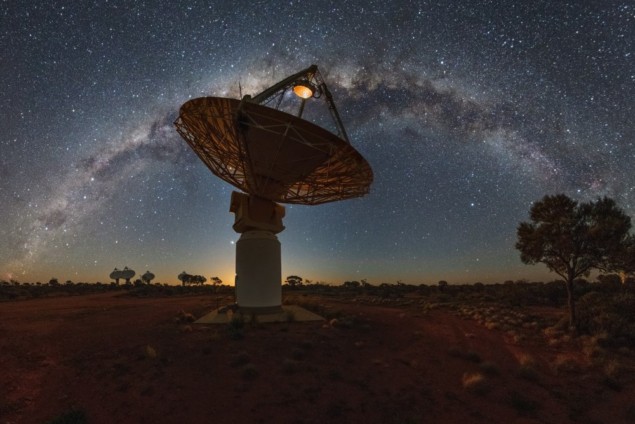
Radio astronomers across the world are bracing themselves for a transformation in their ability to localize fast radio bursts (FRBs). Before the end of the year, upgrades to a suite of FRB-hunting telescopes are expected to increase the localization rate of FRBs to their host galaxies by more than an order of magnitude – potentially revolutionizing our understanding of the universe.
First discovered in 2007, FRBs are intense bursts of radio waves lasting less than a few milliseconds. They come in two main types: either from sources that repeat or those that do not. But of the 1000 or so FRBs to have been detected, only around 3% have been shown to repeat.
As they last for such a short time, it is impossible to schedule follow-up observations, which makes it hard to work out where FRBs come from. All instruments need to stand ready to capture the location of an FRB, whenever it may arrive. Indeed, until recently, astronomers had localized barely two dozen FRBs.
While most FRBs have extragalactic origins, a galactic FRB was recently detected in the Milky Way in 2020 from a magnetar – a neutron star with a large magnetic field. FRBs turn out, however, to be useful for cosmology thanks to a factor called the “dispersion measure” (DM). Measuring the DM allows astronomers to calculate the number of free electrons along the line-of-sight of the FRB and thus directly determine the electron density in the universe.
“These electrons can be hard to observe, since most of them are in very diffuse gas,” says Steffen Hagstotz, a cosmologist the Ludwig Maximilian University of Munich. “In this sense, FRBs are really complementary to other probes such as weak lensing, which mostly tells us about the distribution of dark matter. By studying both, we can learn more about how ordinary matter traces dark matter on cosmological scales.”
There are also various conflicting measurements of the present-day expansion rate of the universe, called the Hubble constant. Reconciling this “Hubble tension” is considered one of the most pressing issues in modern cosmology. FRBs offer an alternative route to determining the Hubble constant by probing the redshift-dispersion measure relation. Hagstotz recently co-authored a study finding that a sample of only about 500 localized FRBs would be sufficient to competitively measure the Hubble constant.
A cracking idea
The present scarcity of localized FRBs has spurred teams of radio astronomers worldwide to squeeze the performance of their facilities. Vikram Ravi from the California Institute of Technology kicked off the FRB race at the American Astronomical Society meeting in January when he announced the localization of 30 new FRBs with the brand new Deep Synoptic Array (DSA) in California. During its commissioning in 2022, DSA detected more than one burst per week using just 63 of the 110 antennae that the DSA will eventually have.
If the DSA is the new kid on the block among radio telescopes, then the Square Kilometer Array Pathfinder (ASKAP) in Western Australia is already a familiar face. Its Commensal Real-Time ASKAP Fast Transients Survey (CRAFT) programme first started localizing FRBs with sub-arcsecond accuracy in 2017, making it possible to study FRB host galaxies. CRAFT piggybacks onto ASKAP by using an FRB-searching compute cluster, which concurrently scans its 30 square degree field of view for radio transients in parallel with other observations.
CRAFT has, until now, operated by incoherently summing the signals from its 36 parabolic dishes, but this is about to change with an upgrade dubbed CRACO. Incoherent summing improves sensitivity by the square root of the number of dishes, while the sensitivity of coherent summation improves sensitivity linearly with the number of dishes.
Coherent searching, however, requires 65,000 times more data processing power, a feat made possible by a A$1m upgrade to the instrument’s computer cluster. “CRACO will be 5 times more sensitive with the same field of view than the current FRB detection system we use on ASKAP,” says Keith Bannister, principal research engineer at Australia’s Commonwealth Scientific and Industrial Research Organisation, which operates ASKAP. Construction go-ahead for €2bn Square Kilometre Array
CRACO works by making a movie of the sky and looking for an FRB in this movie. “The image size is 2.5 million pixels – similar to full HD video,” adds Bannister. “1000 times per second, we try 1000 different DM trials, totalling 1 million images per second – about 25 trillion pixels per second.”
CRACO is currently undergoing a three-month commissioning period, with the expectation that once the full cluster is installed by the end of the year, ASKAP’s detection rate will increase by between 10- and 20-fold, finding several FRBs per week.
While ASKAP pushes the sensitivity frontier to detect more FRBs, the Canadian Hydrogen Intensity Mapping Experiment (CHIME) in British Columbia already has the luxury of detecting several FRBs per day thanks to its staggering field of view of 200 square degrees. However, CHIME’s low resolution means that it can reliably localize FRBs only from nearby galaxies. Engineers at CHIME have chosen to improve performance on the resolution frontier by constructing so-called “outriggers” – identical yet downsized versions of the CHIME telescope.
“The outriggers upgrade of the CHIME/FRB project consists of three mini-CHIMEs,” says Ziggy Pleunis from the University of Toronto. These outriggers, based in British Columbia, West Virginia and California are spread 100–3300 km from CHIME, providing CHIME with about 50 milliarcsecond resolution, enabling it to pin-point FRBs to within their host galaxies.
Work on the outriggers are proceeding rapidly according to Pleunis: “Two have already been constructed and instrumented, and the ground is now being levelled for the third site.” The outrigger in British Columbia is already undergoing commissioning and even collecting data and Pleunis adds that the aim is to have all three telescopes working this year, after which the CHIME/FRB collaboration will optimize their instruments by practicing on known repeating sources before moving on to detecting new ones. “Then we can hopefully quickly start localising FRBs,” he adds.



